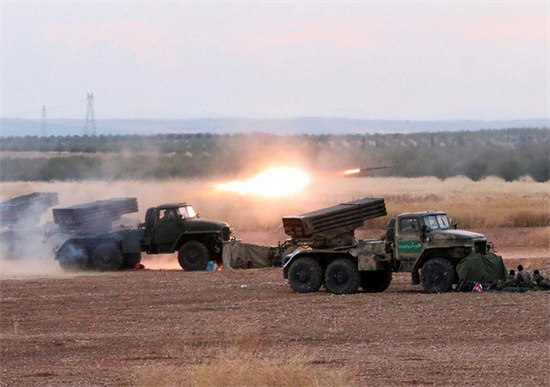Recently, when the war against IS in Syria conducted by international alliance headed by the US has not brought about the expected results, prolonging the conflict, Russia has decided to engage by launching air strikes. Russia’s involvement has resulted in a new development in the region.
Heading a deadlock
Over the past two years, the self-proclaimed Islamic State organization with its key force being fighters of Sunni, who are said to be a US product in the Middle East, has arisen, attacked, carried out massacres and taken control vast areas in Iraq and Syria, threatening security of the region and of the world. Facing the problem, in September 2014, an international alliance consisting of 60 countries led by the US launched air strike operations in Iraq and Syria. However, after more than one year, with thousands of air raids consuming billions of USD, IS has not been destroyed but become fiercer. In reality, IS not only still conducts attacks and holds critical areas in Iraq and Syria but also spreads to other countries like Libya, Greece, Afghanistan and some European countries, etc. Notably, most of the air raids have been conducted by modern fighters, such as F-15, F-16, F/A-18, F-22, AV-8B, B-1 but the results have not met expectations. According to military experts, though the alliance outnumbers and has superior potentials in all fields, they can not defeat IS for the following reasons:
First, US and its allies do not have a clear understanding of the ground in Syria. They do not have intelligent information on the IS installations. These are main factors causing the less effective results of the air raids.
Second, the international ally consists of a number of countries with modern and superior weapons. Yet, each has their own calculations, hence can not make a synergic power.
Third, the US and its allies are not fully aware of the IS capability. Though coming from diffirent countries, IS is well organized and disciplined, mobile and flexible. They change their type of action and attack frequently, can intermingle with civilians easily, and know how to use modern weapons. For these reasons, there is almost impossible to destroy their weapons and vehicles at large scale.
 |
|
Syrian Army attacking IS troop |
Turning point and prospects
Under the propose of Damascus government, on 30 September 2015, Russia launched its air strike operation against the IS in Syria. In a cabinet meeting, Russian President V. Putin stated: “Russian air strikes on Syria not only aims to stabilize the situation there but also contributes significantly to the global war against terrorism.” Observers hold that, Russia’s presence in Syria is changing the game, making the US and its allies no longer be the sole player, and opening up the chance of breaking the deadlock of the conflict. Unlike the operations of the US and its allies, Russia’s air strikes are closely coorperated by the Syrian army operations. As what we have seen, under the support of Russian air strikes, Syrian army has launched large scale offensive operations to protect the road connecting Homs with Hama. This is considered a major advance ensuring the link between Damascus with Syrian central provinces.
The Russia’s involvement has forced the US and Western countries’ to revise their antitude toward the war in Syria. After expressing their criticism and concern, they have to accept Russia’s engagement as a bilateral solution.
Besides, Russia presence in Syria also made other western countries become more eager to participate in operations against IS. French President F. Hollande decided to attack IS targets in Syria to prevent terrorist acts in his homeland. Before that, France only launched attacks against the IS in Iraq. Recently, British Prime Minister D. Cameron also intended to talk with his Senators about launching air strikes against the IS in Syria despite the objection of the opposition. Moreover, Russia engagement in Syria will be a contributor to the proactiveness of Iran, a Russia’s ally in the region, in settling the crisis in Syria. According to observers, Tehran is one of the major factors that help Russia to establish a new alliance against the IS.
The cooperation between Russia and Syrian also changed the attitude of the US and western countries toward Syrian President Bashar al-Assad. Experts stated that international alliance led by the US aware that their strategy that depends on the rebels in Syria has failed. They fear that if present Damascus government falls, IS will fill the gap and Syria will fall into chaos just like the case of Libya post Gaddafi. US no longer considers the resignation of Syrian President B. al Assad a prerequisite for negotiation. France, as well as Britain, Germany, Turkey have also adjusted their tough policies against Damascus with softer ones. These have shown signs of prospects for a political solution for Syrian crisis in order to focus on the war against the IS.
In conclusion, Russia’s determination to engage in the war against IS in Syria has changed fundamentally the 4-year civil war in this country. However, even with Russia’s engagement, the Syrian crisis, is still influenced by factors, each with their own plans and calculations. Though expressing hope to cooperate with Moscow, Washington still suspects the Russia’s real intention when it attacks the rebels backed by US and western countries while protecting the al-Assad regime. Some experts hold that the alliance is making a tricky move to prolong the chaos in Syria in order to remove President B. al-Assad from power. Therefore, a consensus in settling the crisis is hard to reach. International opinions hold that in order to defeat IS and restore peace in Syria, all sides should unite, cooperate in all fields for common goals and soon come to a political solution for the conflict. This is the most feasible path that can bring peace to not only Syria but also to the region and the world. The situation in Syria is experiencing new changes but its prospect and outcome are still unpredictable.
Vu Minh Hoang